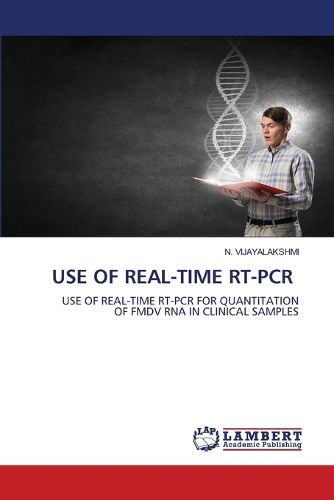Readings Newsletter
Become a Readings Member to make your shopping experience even easier.
Sign in or sign up for free!
You’re not far away from qualifying for FREE standard shipping within Australia
You’ve qualified for FREE standard shipping within Australia
The cart is loading…






Foot-and Mouth Disease virus (FMDV) is diagnosed by virus isolation test combined with antigen ELISA and recently one step RT-PCR. Use of fluorogenic RT-PCR is getting more and more importance for rapid detection of FMDV from clinical samples that cannot be processed by regular virus isolation tests and antigen ELISA. Quantitative real-time RT-PCR (qRT-PCR) combines Reverse Transcription with PCR amplification and detection of positive amplification using fluorescent probes like TaqMan (R) probe. In the present study, a TaqMan(R) probe based qRT-PCR was standardized and used for detection of FMDV genome from clinical samples including nasal secretions, plasma and oesophago-pharyngeal fluids (probang samples). The initial standardization was made using different serial dilutions of a FMDV isolate OTNN 24/84 (106.8 TCID50) and 102 virus could be identified using the TaqMan(R) qRT-PCR. RNA standards were synthesized in vitro from a plasmid containing 110 base pair of 3D region of a FMDV type O isolate.
$9.00 standard shipping within Australia
FREE standard shipping within Australia for orders over $100.00
Express & International shipping calculated at checkout
Foot-and Mouth Disease virus (FMDV) is diagnosed by virus isolation test combined with antigen ELISA and recently one step RT-PCR. Use of fluorogenic RT-PCR is getting more and more importance for rapid detection of FMDV from clinical samples that cannot be processed by regular virus isolation tests and antigen ELISA. Quantitative real-time RT-PCR (qRT-PCR) combines Reverse Transcription with PCR amplification and detection of positive amplification using fluorescent probes like TaqMan (R) probe. In the present study, a TaqMan(R) probe based qRT-PCR was standardized and used for detection of FMDV genome from clinical samples including nasal secretions, plasma and oesophago-pharyngeal fluids (probang samples). The initial standardization was made using different serial dilutions of a FMDV isolate OTNN 24/84 (106.8 TCID50) and 102 virus could be identified using the TaqMan(R) qRT-PCR. RNA standards were synthesized in vitro from a plasmid containing 110 base pair of 3D region of a FMDV type O isolate.